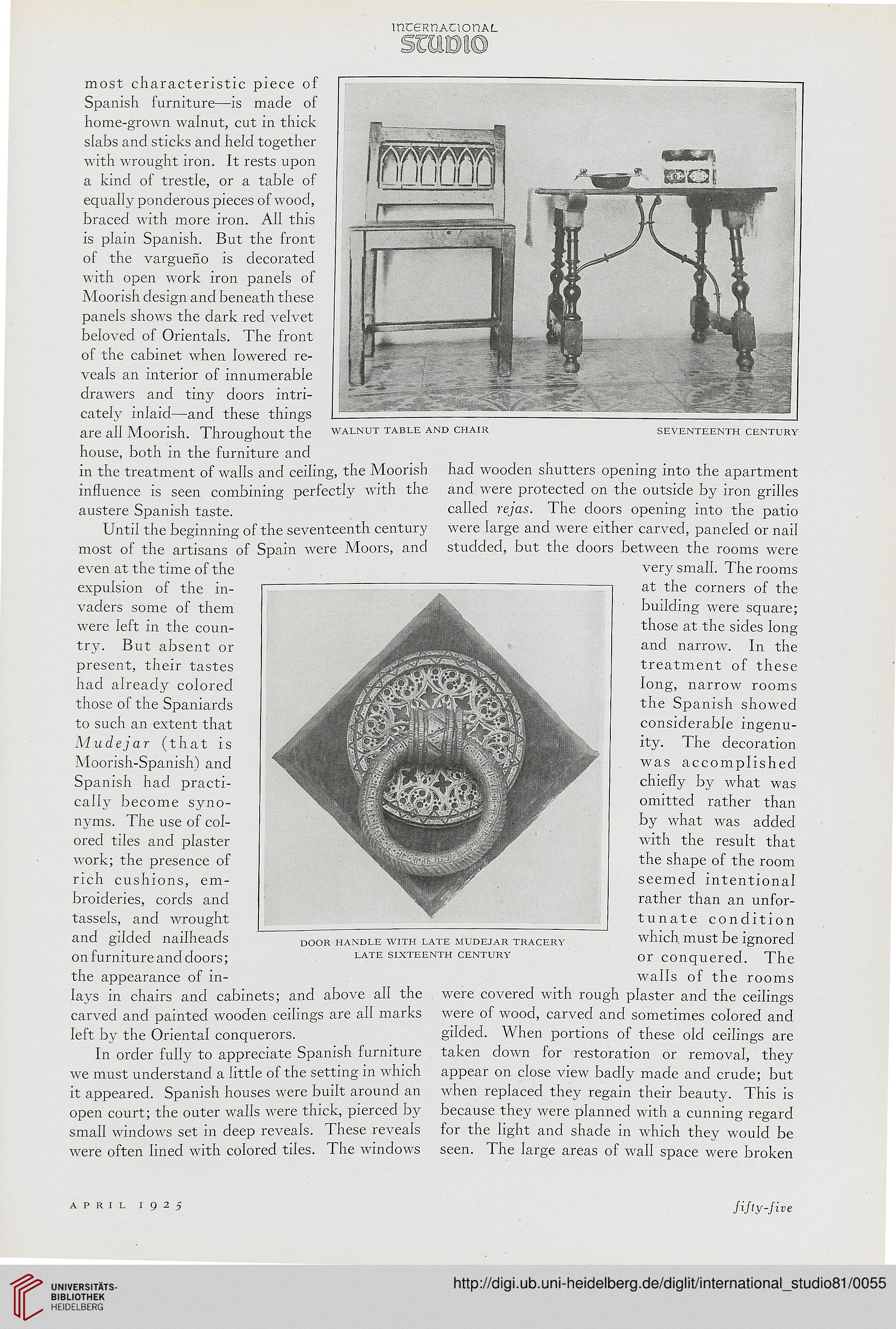inceRHACionAL
most characteristic piece of
Spanish furniture—is made of
home-grown walnut, cut in thick
slabs and sticks and held together
with wrought iron. It rests upon
a kind of trestle, or a table of
equally ponderous pieces of wood,
braced with more iron. All this
is plain Spanish. But the front
of the vargueno is decorated
with open work iron panels of
Moorish design and beneath these
panels shows the dark red velvet
beloved of Orientals. The front
of the cabinet when lowered re-
veals an interior of innumerable
drawers and tiny doors intri-
cately inlaid—and these things
are all Moorish. Throughout the walnut table and chair seventeenth century
house, both in the furniture and
in the treatment of walls and ceiling, the Moorish had wooden shutters opening into the apartment
influence is seen combining perfectly with the and were protected on the outside by iron grilles
austere Spanish taste. called rejas. The doors opening into the patio
Until the beginning of the seventeenth century were large and were either carved, paneled or nail
most of the artisans of Spain were Moors, and studded, but the doors between the rooms were
even at the time of the verY small. The rooms
expulsion of the in- ~~T~ at the corners of^the
tassels, and wrought ___ tunate condition
and gilded nailheads door handle with late mudejar tracery which must be ignored
on furniture and doors; late sixteenth century or conquered. The
the appearance of in- walls of the rooms
lays in chairs and cabinets; and above all the were covered with rough plaster and the ceilings
carved and painted wooden ceilings are all marks were of wood, carved and sometimes colored and
left by the Oriental conquerors. gilded. When portions of these old ceilings are
In order fully to appreciate Spanish furniture taken down for restoration or removal, they
we must understand a little of the setting in which appear on close view badly made and crude; but
it appeared. Spanish houses were built around an when replaced they regain their beauty. This is
open court; the outer walls were thick, pierced by because they were planned with a cunning regard
small windows set in deep reveals. These reveals for the light and shade in which they would be
were often lined with colored tiles. The windows seen. The large areas of wall space were broken
APRIL 1925
Jijty-Jive
most characteristic piece of
Spanish furniture—is made of
home-grown walnut, cut in thick
slabs and sticks and held together
with wrought iron. It rests upon
a kind of trestle, or a table of
equally ponderous pieces of wood,
braced with more iron. All this
is plain Spanish. But the front
of the vargueno is decorated
with open work iron panels of
Moorish design and beneath these
panels shows the dark red velvet
beloved of Orientals. The front
of the cabinet when lowered re-
veals an interior of innumerable
drawers and tiny doors intri-
cately inlaid—and these things
are all Moorish. Throughout the walnut table and chair seventeenth century
house, both in the furniture and
in the treatment of walls and ceiling, the Moorish had wooden shutters opening into the apartment
influence is seen combining perfectly with the and were protected on the outside by iron grilles
austere Spanish taste. called rejas. The doors opening into the patio
Until the beginning of the seventeenth century were large and were either carved, paneled or nail
most of the artisans of Spain were Moors, and studded, but the doors between the rooms were
even at the time of the verY small. The rooms
expulsion of the in- ~~T~ at the corners of^the
tassels, and wrought ___ tunate condition
and gilded nailheads door handle with late mudejar tracery which must be ignored
on furniture and doors; late sixteenth century or conquered. The
the appearance of in- walls of the rooms
lays in chairs and cabinets; and above all the were covered with rough plaster and the ceilings
carved and painted wooden ceilings are all marks were of wood, carved and sometimes colored and
left by the Oriental conquerors. gilded. When portions of these old ceilings are
In order fully to appreciate Spanish furniture taken down for restoration or removal, they
we must understand a little of the setting in which appear on close view badly made and crude; but
it appeared. Spanish houses were built around an when replaced they regain their beauty. This is
open court; the outer walls were thick, pierced by because they were planned with a cunning regard
small windows set in deep reveals. These reveals for the light and shade in which they would be
were often lined with colored tiles. The windows seen. The large areas of wall space were broken
APRIL 1925
Jijty-Jive




